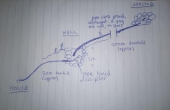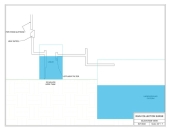Michael Whelchel wrote:Good advice John, glad to know a ram pump can be buried, that will help.
I'd add a caveat or two to that statement regarding ram pump systems being buried:
1) Ram pumps -- though they may work underwater -- require the freedom of motion to have their valves abruptly slam shut during the water hammer effect.
2) Additionally, the discharged water also needs somewhere to flow away.
So a fully buried ram pump underground would not work, as the valve needs to move and the water needs to flow away to keep the machine cycling. A box with the pump would do.
***
Regarding overall system design (especially to deal with flooding turbulent flow) I probably would have the following:
1)
A diverter channel at the stream's headwater entrance, deep enough for the minimal seasonal flow to enter the system, but a safe enough distance away from the main flooding area such that I could service the drive pipe inlet without being swept away by any 100 year floods or sinking into soggy mud.
2)
A vertical settling area and intake screen - preferably square-ishly designed or with baffles perhaps, to reduce vortices and air intake. It should include an inlet filter system, and a method of easily cleaning it out. The system ideally blocks out both floaters and sinkers (organic junk and sediment) from entering the drive pipe component. A cleanout plug at the bottom to discharge sediment would be nice.
3)
Buried (solid) drive-pipe. Solid is more efficient than flexible. I'd prototype to ensure it works first, then trench it in place if soil conditions permit. Reducing vibrations increases system performance. I'd bury it a safe distance away from flooding conditions.
4)
Pump assembly in a (semi-buried) service box:
a) Rodent proof.
b) Houses two pumps:
ram pump above and a
solar pump in a well area below.
c) Depth of box such that the solar pump is always below minimal water depth.
d) Insulated enough for winter freezing conditions, and to muffle annoying valve pulsing sounds.
e) Drive pipe entry hole (with quick coupling fitting for easy removal)
f) Delivery pipe exit hole (also with a quick coupling fitting)
g) Large ram pump discharge water outlet / solar pump water inlet and piping. Placed so that water flows out back to stream's course in an erosion-free manner
as well as inward to supply the solar pump with water. Another filter system to support this solar pump inlet. Also placed a safe distance away via a diverter channel.
h) Perhaps some kind of manifold system to choose where the water flows to and to enable easy testing, clean out, or future expansion.
i) I haven't invented or patented this yet, but I want to design a ram pump servo pulser: Basically, a device to remotely start or stop a ram pump, whether on command or automatically. I'd make this home-made ram pump pulser using a hobby servo motor and simple micro-controller.
j) Maybe a "low water" solar pump controller to prevent running the solar pump when dry, plus to turn it on when a certain storage threshold is met.
5)
Buried & surface delivery pipes.
a) The first pipe would be permanently buried at a nice depth. It's temperature would be closer to 55*F year round.
b) The second one would be temporary, and rest on the surface. It would be black piping plus plastic soda bottle "insulation", and it would go up to the balcony for a rudimentary hot water shower system. The storage might also have a thermosiphon. The storage on the balcony would enable one to take a hot shower on the deck with out any motorized pumps. Once the shower bin is full, it could reticulate to other systems, such as the greenhouse water storage.
I have a (different) design site in mind for such a ram pump + solar powered water delivery system, so if I ever build one myself, I'll let you all know how it works out.

 3
3




 6
6




 3
3




 5
5




 3
3




 3
3




 2
2




 5
5




 2
2




 5
5




 2
2




 2
2




 2
2




 2
2




 1
1




 1
1














